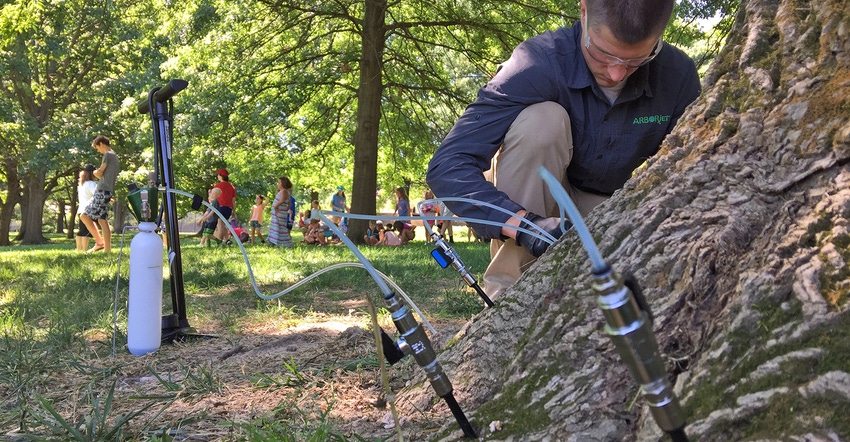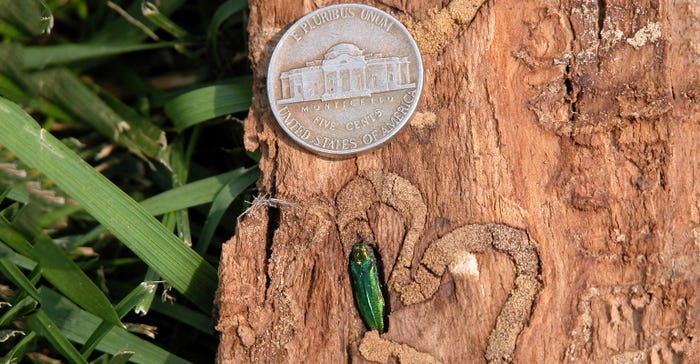
Kneeling beside a 70-year ash tree, Emmett Muennink places what appear to be large needles in the base of the tree. As children from summer camps walked by, they questioned what the needles and tubing were doing to the tree. Then one youngster commented, "He's injecting it with science."
The description is not too far off, according to Muennink, because the process is like giving a tree an IV full of medicine that will protect it from emerald ash borer. The south-central technical manager for Arborjet has spent the last three years traveling six states trying to save ash trees from the tree-killing pest.

DEADLY PEST: The adult emerald ash borer (EAB) is a half-inch long and dark, metallic green. Learn how to identify this invasive pest at eab.missouri.edu. (Eric R. Day, Virginia Polytechnic Institute and State University, Bugwood.org)

What to look for
The adult is a small, metallic-green beetle native to Asia that only attacks ash trees. It is just 10 to 15 mm in length and 3 mm in width. Adult beetles typically emerge in early summer, leaving exit holes in the bark. They briefly feed on the canopy and cause very little damage to the tree itself. It is when they start reproducing and laying eggs in the branches and trunk that creates problems.
The larval stage is what actually causes tree death. The larvae live under the bark of the tree and feed on the tree's vascular system, cutting off nutrient and water uptake, Muennink explains. Unfortunately, emerald ash borer (EAB) kills more than 99% of the ash trees it attacks within three to four years of infestation.
Treatment procedure
Muennink says that just because a tree shows signs of EAB does not mean it has to be cut down. "We are able to give a tree an injection of a chemical product and give it a chance," he says.

PRESCRIPTION BASIS: The diameter of the tree is used to calculate the precise amount of chemical to inject into the tree base. Then the vascular system of the tree takes the chemical through the branches and into the leaf canopy.

Arborjet offers a trunk injection treatment known as TREE-äge. To use this treatment, Muennink starts by measuring the diameter of the tree. This allows him to know just how much insecticide and how many injection sites are needed.
Next, using a drill, he bores into the base of the tree trunk. "We are tapping into the vascular tissue and introducing the product," he says. "The tree will transport the product systemically into the canopy, just as the water is taken up."
With a hammer, Muennink carefully taps in black plugs into the holes. "This seals the product inside the tree and also prevents decay from entering," he says. "It is an environmentally responsible way to use pesticides. There is no exposure to the applicator or environment."
Next, he inserts an injection "needle" into each plug. The injection sites are typically on the bottom 18 inches of a tree, around 6 inches apart. Tubes from a canister deliver the product to the vascular system. A 10-inch diameter tree receives roughly 1.5 ounces of the injected treatment.
Then Muennink waits. It is time to let the tree do a little work. Just as water flows from the base to the canopy, he can watch as the blue chemical moves through the tubes and into the tree. It takes roughly 30 minutes for each TREE-äge treatment. He tries to plan injection treatments in the morning when the trees are likely to "get a drink of water" from the ground.
Once the treatment is complete, Muennink removes the injectors. The bark will grow over the plugs in the years to come.
Arborjet's product can last up to two years. It can be applied any time during the growing season, as long as there is foliage on the tree.
Replacement costs
Muennink contends that an injection treatment far outweighs removal or replacement costs.
To remove a tree that is 70 years old and 30 inches in diameter could cost up to $4,000. Treatment is just about $100 a year, depending on size.

WORTH SAVING: This ash tree is considered a "heritage tree" because it is more than 30 inches in diameter. It has been in the park for more than 70 years.

But it is the tree loss that bothers Muennink. As he injects the "heritage tree," which is a tree having a 30-inch diameter or greater, he comments on just how long it would take to grow back. "This tree is probably 70 years old, maybe older," he says. "Cutting it down and replacing with a 10-inch tree — you just lost 70 years of growth. Then you wait another 70 years for a canopy this large."
The bottom line, according to Muennink, is that individuals have a lot more options today to treat for emerald ash borer, if they start early.
About the Author(s)
You May Also Like






